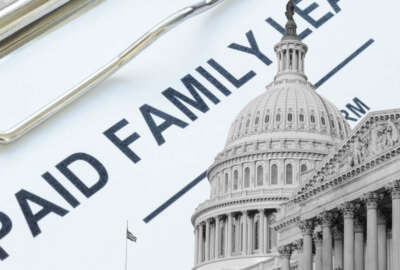
Paid federal parental leave will cost $3.3B over 5 years, but that’s not the whole story
The Congressional Budget Office's price tag on paid parental leave does not take into account employee turnover.
The plan to give federal workers 12 weeks of paid parental leave may end up costing about $3.3 billion over the next five years, but that number may not take into account the whole story.
A report from the Congressional Budget Office estimates the Federal Employee Paid Leave Act — which gives federal employees 12 weeks of paid leave after birthing, adopting or fostering a child — will cost about $774 million in 2021. That price increases to $817 million in 2022, and $846 million in 2023.
CBO estimates the 10 year cost of the plan will be about $8.1 billion.
CBO’s score only takes into account the cost increases from allowing employees to use paid leave in situations where they are using unpaid leave, paid leave or sick leave.
There may be some other financial impacts of the bill that CBO isn’t taking into account, however.
The National Partnership for Women and Families estimated the program could save government $50 million in reduced employee turnover costs and prevent the departure of more than 2,600 women from the federal workforce.
Lawmakers also note that paid parental leave gives the government a better chance of recruiting and retaining its employees.
“Our workforce is also aging, creating a shortage of family caregivers and leaving that responsibility to family members,” lawmakers wrote in an Aug. 19 letter to the chairman and ranking member of the House Armed Services Committee urging them to add parental leave to the 2020 national defense authorization bill. “Only 8% of the federal workforce is under 30, compared to 24% of the total labor force. With more than 31% of the federal workforce eligible to retire within the next five years, we have major recruitment challenges on the horizon. Offering paid family leave is a good first step towards meeting them.”
The United States is the only industrialized nation that does not provide paid parental leave to its federal employees.
Members of Congress added the parental leave provision to the conference report of 2020 defense authorization bill earlier this month.
The leave applies to both men and women, and federal employees would have access to it starting in October 2020.
The benefit does not, as prior versions of this legislative proposal suggested, apply to federal employees who want paid time off to care for a sick family member or recover from their own serious medical condition.
The House overwhelmingly passed the conference report on Dec. 11. The Senate still needs to pass its version before it goes to the president.
Federal employee groups and unions applauded the agreement on the paid parental leave program, calling a “watershed,” “life-changing” moment for the federal workforce.
“This is a monumental step forward in allowing federal employees to bond with their new children whether a new birth, adoption or foster,” Tony Reardon, national president of the National Treasury Employees Union, said in a statement. “It is a crucial time in their lives, and they shouldn’t have to choose between their children and their paycheck.”
Copyright © 2024 Federal News Network. All rights reserved. This website is not intended for users located within the European Economic Area.
Scott Maucione is a defense reporter for Federal News Network and reports on human capital, workforce and the Defense Department at-large.
Follow @smaucioneWFED




